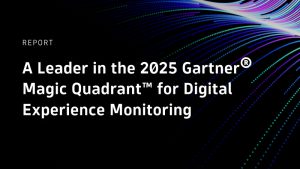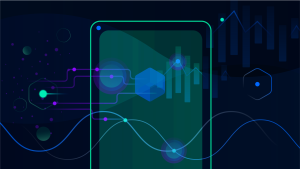Automatically discover and remediate problems with digital experience monitoring for a greater user experience.
Fast, consistent application delivery creates a positive user experience that can ultimately drive customer loyalty and improve business metrics like conversion rate and user retention. Digital experience monitoring (DEM) allows an organization to optimize customer experiences by taking into account the context surrounding digital experience metrics. Understanding why a user is experiencing transactional or performance issues enables organizations to achieve greater observability that goes beyond metrics, traces and logs. DEM can give organizations business observability—insight into the effects of user experience on the bottom line.
Digital experience monitoring enables companies to respond to issues more efficiently in real time, and, through enrichment with the right business data, understand how end-user experience of their digital products significantly affects business key performance indicators (KPIs).
Gartner estimates that by 2025, 70% of digital business initiatives will require infrastructure and operations (I&O) leaders to include digital experience metrics in their business reporting. In what follows, we’ll define digital experience monitoring, the primary types of monitoring tools, the role it plays in end-to-end observability, and how it ties to automatic and intelligent AIOps (or AI for IT operations).
What is digital experience monitoring?
Digital experience monitoring is the practice of using tools and technologies to gather and evaluate metrics as a customer navigates an application to determine the quality of a user’s interaction with its digital touchpoints. DEM provides an outside-in approach to user monitoring that measures user experience (UX) in real time to ensure applications and services are available, functional, and well-performing across all channels of the digital experience, including web, mobile, and IoT.
DEM solutions extend application performance monitoring (APM) to include the front-end UX — also referred to as end-user experience monitoring (EUEM) — with capabilities that monitor and provide the following:
- Application performance: Average response time, error rate, load time, usability, and other data that impacts the UX.
- Synthetic transactions: Simulated user behavior generated by scripts for different scenarios, geographic locations, device types, and other variables.
- Real user behavior: Captures and analyzes each real-time activity to determine a user’s needs and identify patterns in how a user interacts with an application.
- Digital experience insights: Session replays of qualitative user data such as mouse movement, clicks, tapping, scrolling, and page visits for an unbiased evaluation of user behavior and intent.
- User experience scoring: AI-driven identification of whether users are satisfied, frustrated, or simply tolerating the digital experience.
One of the key advantages of DEM is its versatility. With DEM solutions, organizations can operate over on-premise network infrastructure or private or public cloud SaaS or IaaS offerings.
Primary digital experience monitoring tools
A digital monitoring solution typically uses one or more of the following three monitoring approaches, depending on an organization’s needs and priorities:
- Synthetic transaction monitoring (STM). STM generates traffic that replicates the typical path or behavior of a user on a network to measure performance for example, response times, availability, packet loss, latency, jitter, and other variables). It is proactive monitoring that simulates traffic with established test variables, including location, browser, network, and device type. One use case for STM is to model the behavior of a customer in the form of a flow of transactions along the buyer’s journey. Another is to monitor third-party APIs that a business application depends on for critical functions.
- Real-user monitoring (RUM). RUM is passive monitoring that measures a user’s interactions with an application — typically with a JavaScript tag for web applications or a software development kit (SDK) for native mobile apps. Collected telemetry data may include the type of device being used (cellphone, tablet, smart watch), geographical location, server response time, performance, and security. RUM use cases include monitoring an online retailer’s site to detect any increases in page load time, tracking users’ paths through a conversion funnel, or analyzing adoption of new mobile app versions.
- Endpoint monitoring (EM). EM gives visibility into the user device and performance from the endpoint to provide information on CPU, memory, operating systems, storage, security, networks, and whether software is up to date. Endpoints can be physical (i.e., PC, smartphone, server) or virtual (virtual machines, cloud gateways). EM can identify an anomaly quickly, so an issue can be fixed before it disrupts business operations and impacts an employee or customer experience. Another use case is ensuring always-on app functionality for a remote workforce.
How digital experience monitoring changes the game
Digital experience monitoring helps an enterprise understand and translate complex front-end performance, user behavior, and API technology along the digital supply chain into actionable KPIs that enable better business outcomes. A modern DEM solution provides analytics for key application performance indicators across web, mobile, and IoT channels, providing a detailed overview of user behavior. These indicators may include release success, adoption rate, and conversions (for example, in-app actions taken by a user such as a purchase, inquiry, or signup).
Armed with these insights about how users navigate a digital product and which features they adopt or ignore, a business can optimize the user journey. This enables a business to provide a more appealing and consistent UX for greater user retention and conversion rates. The ability to monitor and analyze user behavior ultimately delivers better customer experiences and collaboration between IT and business teams, which result in better business results.
Role of DEM in achieving end-to-end observability
Digital experience monitoring extends observability throughout the technology stack with an outside-in perspective of application performance across all user touchpoints. Expanding on the traditional observability pillars of metrics, logs, and traces, DEM collects user experience data to complete the end-to-end picture.
Solutions that focus on metrics, logs and traces can capture and alert teams to performance issues but cannot provide visibility into how many real users are impacted or what their individual sessions looked like. For example, there may be a service problem that causes a large increase in response time but the ultimate impact on the user could be trivial or huge. Without insight into the impact on end users and the ability to drill down into their user sessions, it’s difficult to prioritize which problems to focus on to deliver a better customer experience.
What DEM and business observability mean for the bottom line
Business observability incorporates business metrics and processes into an observability solution, enabling business and IT teams to connect the full technology stack to business outcomes. Enriching digital experience monitoring with business data, such as revenue, order value, or customer segments helps to connect the dots and remove silos between technology KPIs and business metrics.
Business observability makes it possible to see the true impact of digital experience metrics on the business and therefore make more informed decisions about where to prioritize and focus efforts. For example, understanding that an issue is preventing high-value customers from completing a transaction versus slowing down a low-volume search query is critical business insight. Analyzing this type of data over time to predict trends gives insights into current and future customer behavior and the ability to design an optimal UX as needed to fulfill business objectives — ultimately increasing revenue.
DEM and business observability also help to ensure that software releases meet expected business goals, and I&O reporting meets internal and external service- level objectives for business and IT metrics.
How automatic and intelligent AIOps makes DEM and business observability possible
Dynatrace’s Digital Experience and Business Analytics real-time, user-centric observability provides visibility, context, and insights into end user experience and how it relates to business outcomes. With intelligent AIOps powered by Dynatrace’s AI engine Davis, you can automatically discover problems within production and development environments before customers overload a call center with complaints, launch a diatribe on social media, or simply stop using an organization’s digital product.
With Dynatrace’s context-specific drill downs and service analysis, you can pinpoint exactly how a service is affecting an application and automate prioritization of tasks based on context and impact on critical business KPIs. It is also simple to enhance digital experience monitoring data with customer segmentation, web analytics, and voice of customer data for more fine-tuned visibility into the business impact of individual customers and key segments.
Learn more about Dynatrace today with this Power Demo: Dynatrace and Business Observability: Tying IT Metrics to Business Outcomes.





Looking for answers?
Start a new discussion or ask for help in our Q&A forum.
Go to forum